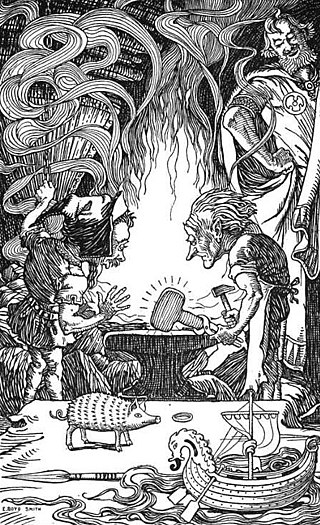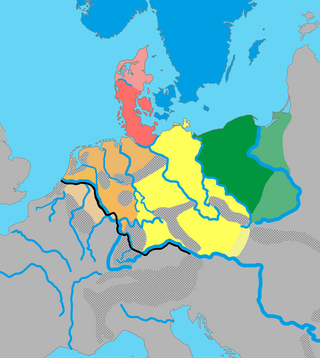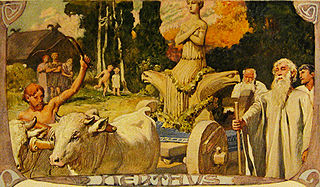Related Research Articles

Freyr, sometimes anglicized as Frey, is a widely attested god in Norse mythology, associated with kingship, fertility, peace, prosperity, fair weather, and good harvest. Freyr, sometimes referred to as Yngvi-Freyr, was especially associated with Sweden and seen as an ancestor of the Swedish royal house. According to Adam of Bremen, Freyr was associated with peace and pleasure, and was represented with a phallic statue in the Temple at Uppsala. According to Snorri Sturluson, Freyr was "the most renowned of the æsir", and was venerated for good harvest and peace.

In Norse mythology, Freyja is a goddess associated with love, beauty, fertility, sex, war, gold, and seiðr. Freyja is the owner of the necklace Brísingamen, rides a chariot pulled by two cats, is accompanied by the boar Hildisvíni, and possesses a cloak of falcon feathers. By her husband Óðr, she is the mother of two daughters, Hnoss and Gersemi. Along with her twin brother Freyr, her father Njörðr, and her mother, she is a member of the Vanir. Stemming from Old Norse Freyja, modern forms of the name include Freya, Freyia, and Freja.

In Norse mythology, Njörðr is a god among the Vanir. Njörðr, father of the deities Freyr and Freyja by his unnamed sister, was in an ill-fated marriage with the goddess Skaði, lives in Nóatún and is associated with the sea, seafaring, wind, fishing, wealth, and crop fertility.

Skíðblaðnir, sometimes anglicized as Skidbladnir or Skithblathnir, is the best of ships in Norse mythology. It is attested in the Poetic Edda, compiled in the 13th century from earlier traditional sources, and in the Prose Edda and Heimskringla, both written in the 13th century by Snorri Sturluson. All sources note that the ship is the finest of ships, and the Poetic Edda and Prose Edda attest that it is owned by the god Freyr, while the euhemerized account in Heimskringla attributes it to the magic of Odin. Both Heimskringla and the Prose Edda attribute to it the ability to be folded up—as cloth may be—into one's pocket when not needed.

Yule is a winter festival historically observed by the Germanic peoples that was incorporated into Christmas during the Christianisation of the Germanic peoples. In present times adherents of some new religious movements celebrate Yule independently of the Christian festival. Scholars have connected the original celebrations of Yule to the Wild Hunt, the god Odin, and the heathen Anglo-Saxon Mōdraniht. The term Yule and cognates are still used in English and the Scandinavian languages as well as in Finnish and Estonian to describe Christmas and other festivals occurring during the winter holiday season. Furthermore, some present-day Christmas customs and traditions such as the Yule log, Yule goat, Yule boar, Yule singing, and others may have connections to older pagan Yule traditions.

Æsir or ēse are gods in Germanic paganism. In Old Nordic religion and mythology, the precise meaning of the term "Æsir" is debated, with it being able to refer to both the gods in general or specifically to one of the main families of gods, in contrast to the Vanir, with whom they waged war, ultimately leading to a joining of the families. The term can further be used to describe local gods that were believed to live in specific features in the landscape such as fells. In the Old English Wið færstice, the Ēse are referred to, along with elves, as harmful beings that could cause a stabbing pain, although exactly how they were conceived of by the author of the text is unclear.

In Norse mythology, the Vanir are a group of gods associated with fertility, wisdom, and the ability to see the future. The Vanir are one of two groups of gods and are the namesake of the location Vanaheimr. After the Æsir–Vanir War, the Vanir became a subgroup of the Æsir. Subsequently, members of the Vanir are sometimes also referred to as members of the Æsir.

Old Norse Yngvi, Old High German Ing/Ingwi and Old English Ing are names that relate to a theonym which appears to have been the older name for the god Freyr. Proto-Germanic *Ingwaz was the legendary ancestor of the Ingaevones, or more accurately Ingvaeones, and is also the reconstructed name of the Elder Futhark rune ᛜ and Anglo-Saxon rune ᛝ, representing ŋ.

Gullinbursti is a boar in Norse mythology.

The Ingaevones were a Germanic cultural group living in the Northern Germania along the North Sea coast in the areas of Jutland, Holstein, and Frisia in classical antiquity. Tribes in this area included the Angles, Frisii, Chauci, Saxons, and Jutes.

In Germanic paganism, Nerthus is a goddess associated with a ceremonial wagon procession. Nerthus is attested by first century AD Roman historian Tacitus in his ethnographic work Germania.

Blót and blōt or geblōt are terms for "blood sacrifice" in Norse paganism and Anglo-Saxon paganism respectively. A comparanda can also be reconstructed for wider Germanic paganism.

Heitstrenging (pl. heitstrengingar) is an Old Norse term referring to the swearing of a solemn oath to perform a future action. They were often performed at Yule and other large social events, where they played a role in establishing and maintaining good relationships principally between members of the aristocratic warrior elite. The oath-swearing practice varied significantly, sometimes involving ritualised drinking or placing hands on a holy pig that could later be sacrificed. While originally containing heathen religious components such as prayers and worship of gods such as Freyr and Thor, the practice continued in an altered manner after the Christianisation of Scandinavia.
Fjörgyn is a personification of earth in Norse mythology, and the mother of the thunder god Thor, the son of Odin. The masculine form Fjörgynn is portrayed as the father of the goddess Frigg, the wife of Odin.

*Fraujaz or *Frauwaz, feminine *Frawjōn is a Common Germanic honorific meaning "lord", "lady", especially of deities.

Norse, Nordic, or Scandinavian mythology is the body of myths belonging to the North Germanic peoples, stemming from Old Norse religion and continuing after the Christianization of Scandinavia, and into the Nordic folklore of the modern period. The northernmost extension of Germanic mythology and stemming from Proto-Germanic folklore, Norse mythology consists of tales of various deities, beings, and heroes derived from numerous sources from both before and after the pagan period, including medieval manuscripts, archaeological representations, and folk tradition. The source texts mention numerous gods such as the thunder-god Thor, the raven-flanked god Odin, the goddess Freyja, and numerous other deities.

This Viking Age runestone, designated as G 181 in the Rundata catalog, was originally located at a church at Sanda, Gotland, Sweden, and is believed to depict the three Norse pagan gods Odin, Thor, and Freyr.
The sonargǫltr or sónargǫltr was the boar sacrificed as part of the celebration of Yule in Germanic paganism, on whose bristles solemn vows were made in some forms of a tradition known as heitstrenging.
In Norse mythology, the sister-wife of Njörðr is the unnamed wife and sister of the god Njörðr, with whom he is described as having had the twin children Freyr and Freyja. This shadowy goddess is attested to in the Poetic Edda poem Lokasenna, recorded in the 13th century by an unknown source, and the Heimskringla book Ynglinga saga, a euhemerized account of the Norse gods composed by Snorri Sturluson also in the 13th century but based on earlier traditional material. The figure receives no further mention in Old Norse texts.

Germanic boar helmets are attested in archaeological finds from England and Sweden, dating to Vendel and Anglo-Saxon periods, and Old English and Old Norse written sources. They consist of helmets decorated with either a boar crest or other boar imagery that was believed to offer protection in battle to the wearer. They have also been proposed to be a costume for the ritual transformation into a boar, similar to berserkers, and to be associated with Freyr.
References
- ↑ Lindow, John. 2002. Norse Mythology: A Guide to the Gods, Heroes, Rituals, and Beliefs . New York: Oxford University Press. ISBN 0-19-515382-0.
- ↑ Schröder, Franz Rolf. 1941. Untersuchungen zur germanischen und vergleichenden Religionsgeschichte. Vol. 1, Ingunar-Freyr. Tübingen: J.C.B. Mohr.